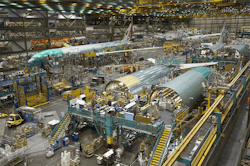Aviation Industry Sticking with New Adhesives Packaging Process
The aerospace industry is expected to grow 2.3% annually until the end of 2025, and the maintenance, repair, and overhaul of various aircraft could climb to $121.8 billion, Aviation Week reports. Fancy, new technologies such as direct metal laser sintering Titanium aim to cut costs by making aircraft more lightweight, resulting in lower fuel costs. Also, DMSL is an additive process, so no metal, or waste, is left behind.
Cost-cutting isn't only achieved by new technologies; sometimes a new spin on an old one will work just as well, as Adhesive Packing Specialties has learned with its polysulfide meter-mixing process. The proprietary process was developed after Royal Holdings, which developed a lightweight polysulfide for the aerospace industry, bought the 38-year-old company for its expertise in mixing and freezing adhesives in late 2012. Some of the largest aerospace manufacturers have contracts with the two until 2019.
Steve Buchanan, president of Adhesive Packaging Specialties since 1996, explains how the merger and new process have ensured the company will stick around the aviation industry for the foreseeable future.
What were some factors that led to Royal buying APS?
Royal wanted a way to package its polysulfides. The biggest thing about polysulfides are the strength of bonding metal. Royal has made it lightweight, which makes them the cat's meow in the industry right now. They were encountering some packaging problems, which involves mixing the A and B components, injecting them into cartridges and freezing them.
We already had AS9100 certification, allowing us to sell to the industry, and we understood the lingo because of compliance and specs. We were halfway there. And working with frozen products was already ingrained in us. We could walk right in without a few hiccups. The development didn't start from scratch, but was enhanced by our interaction and history. We attacked it head on and brainstormed for months. We tested it and it worked beautifully.
What's so special about it?
It takes the chemistry out of production. These would normally be mixed in the factory and go out to production.
A lot of the traditional machines really butcher the material, just bang it together and hurts some of the properties that make it so lightweight and strong. We used the existing design using metering sleeves to achieve the perfect ratio, but built in proprietary parts that are found nowhere else in the industry in order to do this mixing and dispense it into the cartridges. The sealants, which can come in 6 oz. cartridges or 1 oz. jars, are frozen and stored in -70° F freezers. Once the manufacturer receive it and is ready to use it, it can thaw out for about 30 minutes. The cure can be realized in five or 10 hours once it's on the part.
How do you make sure this process doesn't yield "butchered material"?
It's 100% QC. A small sample of each cartridge is tested. It's called the button system, and it checks for cure consistency, uniformity, and to make sure there is no air entrapment.
Any major changes since the process's inception?
It is always being tinkered with in the sense that it's a relatively slow process, by my standards as a packager. We are meeting the demands of the industry so far and have several machines, but we are working on improving the speed.
Any issues with shipping frozen, perishable products?
We can ship around the world, but it becomes very cost-prohibitive the further it gets from our facility in Peabody, Mass. The real key to the freezing it has to be -40 or colder. Any time it's less than that the guarantee is off. The material can semi-cure in a cold state and no manufacturer wants to guarantee something that's warmer.
What's the cost benefit?
The real glaring one is you don't waste. Just use what you need. 30 years ago would buy 1 or 5 gallons and they're be more thrown away than used. When you buy 1,000 tons of something and waste half of it, it's a lot of money, especially in the aviation industry with these giant planes aircraft. And the industry has been on a growth pattern, because saving fuel and making the planes more lightweight has been such a focus.
About the Author
John Hitch
Editor, Fleet Maintenance
John Hitch, based out of Cleveland, Ohio, is the editor of Fleet Maintenance, a B2B magazine that addresses the service needs for all commercial vehicle makes and models (Classes 1-8), ranging from shop management strategies to the latest tools to enhance uptime.
He previously wrote about equipment and fleet operations and management for FleetOwner, and prior to that, manufacturing and advanced technology for IndustryWeek and New Equipment Digest. He is an award-winning journalist and former sonar technician aboard a nuclear-powered submarine where he served honorably aboard the fast-attack submarine USS Oklahoma City (SSN-723).

